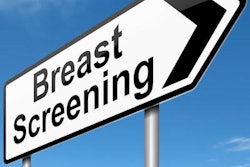
Follow-up breast MRI can be part of an effective workup protocol for women who have undergone a breast MRI screening exam that identified lesions categorized as BI-RADS 3, or "probably benign," according to research presented at the American Roentgen Ray Society (ARRS) annual meeting in Honolulu.
The results suggest that, when used prudently, short-interval follow-up MRI is an effective way to identify early-stage breast cancer among these patients, wrote a team led by study co-author Dr. Leslie Lamb of Massachusetts General Hospital (MGH) in Boston.
"This study clarifies that probably benign assessments can be as useful for MRI as they are for mammography," Lamb said in a statement released by the ARRS.
Breast MRI is considered the most sensitive modality for detecting breast cancer, but not much is known about its performance for follow-up on findings classified as BI-RADS 3. Furthermore, insurers may not cover follow-up breast MRI, the group noted.
Lamb and colleagues sought to investigate the frequency and cancer yield of BI-RADS 3 lesions in patients undergoing baseline versus nonbaseline screening MRI exams in women at high risk for breast cancer.
The study included 6,672 screening MRI exams performed in 3,214 patients between 2011 and 2015. Of these exams, 3% were categorized as BI-RADS 3. Among the baseline MRI exams, 8.3% were categorized as BI-RADS 3; among the nonbaseline MRI exams, 2.1% were placed in this category.
The researchers also found the following:
- 13 of 202 (6.4%) of the lesions categorized as BI-RADS 3 were malignant, with 12 of these described as either stage 0 or I.
- 2.4% of the BI-RADS 3 baseline exams showed cancer, while 9.2% of the cancers found in the nonbaseline studies showed malignancy.
- Of the 13 cancers, eight were foci, three were nonmass enhancement, and two were masses. Ten of these 13 cancers were upgraded at the six-month follow-up MRI or before.
"Most cancers diagnosed on follow-up of BI-RADS 3 lesions are early stage, and most are diagnosed at or before the six-month follow-up," the researchers wrote.
The study indicates most cancers diagnosed on follow-up of BI-RADS 3 are the ones clinicians want to catch, said co-author Dr. Christine Edmonds, also at MGH, in the ARRS statement.
"Many patients and providers question the utility of BI-RADS 3 in MRI, particularly as some insurers do not cover the costs of the short-interval follow-up MRIs," she said. "This study clarifies that short-interval follow-up MRI is a valuable method of identifying early-stage breast cancer while avoiding unnecessary biopsies."




















